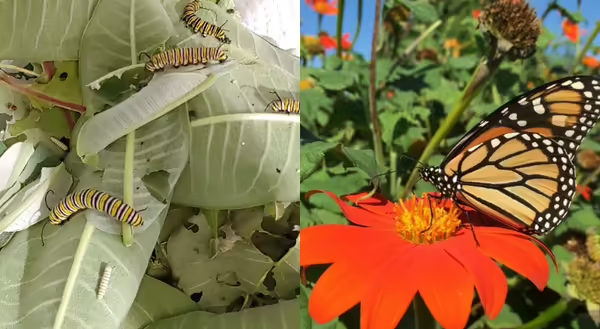
BLOOMINGTON, Ill. – The state insect, the monarch butterfly, is facing a crisis. Each May, Illinoisans celebrate the monarch butterfly, but University of Illinois Extension Horticulture Educator Kelly Allsup says that Illinois residents should be worried.
The yearly count of monarchs decreased by 53% in 2019 from the following year, says Allsup. "This most recent drop may not be directly correlated to our reduced milkweed numbers; drought and other environmental factors are also contributing to the problem; however, the decrease in the monarch population over time can be attributed specifically to a lack of milkweed for larvae." Milkweed is the only plant that monarchs will lay eggs on, and it is the sole food source for monarch larvae when eggs hatch. Read more on milkweed from Penn State Extension.
In December of 2020, monarch butterflies were eligible to be added to the Endangered Species List. Instead, they were added to the waitlist. “Getting put on the candidate waiting list is better than getting denied,” says Center for Biological Diversity conservation biologist Tierra Curry, quoted in a recent Smithsonian Magazine article. In response, the Illinois Monarch Action Plan attempts to grow the number of milkweed plants substantially.
The plan addresses four sectors of land in Illinois: agricultural, urban, natural areas, and roadsides. Its goal is to plant 150 million new milkweed plants by 2038.
"Every stem will help," says Austin Omar, Illinois Farm Bureau associate director of natural resource policy and leader of the agriculture sector committee. He notes that it is important that residents of Illinois document their monarch habitat that they may be planting or stewarding through various ongoing programs, so they can be counted, and so monarch conservation progress can be tracked. Some of these programs are listed below.
There are many ways individuals can help rebuild the monarch population, Allsup says.
- I-Pollinate Citizen Scientist program, a research initiative of University of Illinois, enlists citizens to collect data on monarch egg and caterpillar abundance, pollinator visitation to ornamental flowers, and state bee demographics.
- Plant a Pollinator Pocket garden that attracts and nurtures pollinators in your own yard.
- Register with the Monarch Waystation to support monarch conservation. "Your efforts ensure the preservation of the species and the continuation of the spectacular monarch migration phenomenon," Allsup says.
- Plant milkweed. A 10 square-foot garden of milkweed creates about 150 stems. Illinois Natural History Survey plant ecologists say swamp milkweed (Asclepias incarnata) is the preferred milkweed species of Monarchs, along with Butterfly weed (Asclepias tuberosa), Common milkweed (Asclepias syriaca), Prairie milkweed (Asclepias sullivantii) and Whorled milkweed (Asclepias verticillata). For optimum benefit, establish groupings of plants in full sun and eliminate pesticide use.
- Include nectar sources throughout the entire growing season.
- In spring: Chives, Culver’s Root, Viburnum, High bush blueberry, and Amelanchier
- In summer: Salvia, Coneflower, Prairie Blazing Star, and Buttonbush
- In fall: Monarda, Aster, Goldenrod, Sedum, and Lead plant
- Plant blooming annuals, such as Salvia, Zinnias, Cosmos, Lantana, Mexican Sunflower, and Lavender
- Plant a ground cover of White Clover, Creeping Thyme, or Buckwheat
"Every stem of milkweed and garden nectar source planted will contribute not only to the survival of the monarchs, but also many other wildlife, pollinators, and birds," Allsup says.
SOURCE: Kelly Allsup, University of Illinois Extension Horticulture Educator
Photo Caption: Monarch Caterpillar and Butterfly, provided by R. Carter and K. Allsup